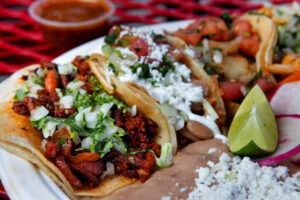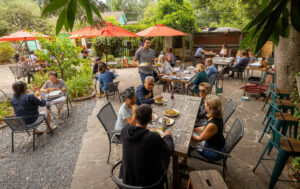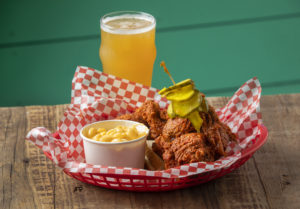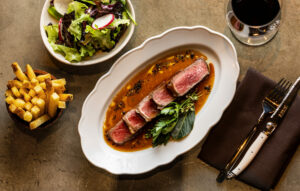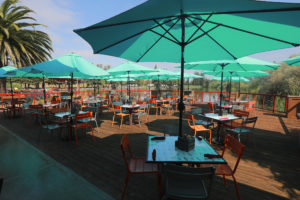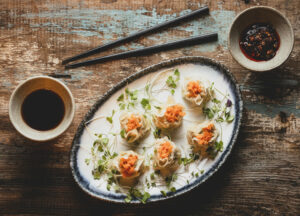 This dish came about, like so much of what transpires here in the PK, because it was the obvious thing to do: Driving home with my eldest daughter, we stopped by the small but exceptional Tuesday market. We had very little time were already behind schedule for dinner, so prep time had to be short. And, of course, the ultimate test for any kids’ meal: Would the little monsters actually eat whatever I put in front of them?
This dish came about, like so much of what transpires here in the PK, because it was the obvious thing to do: Driving home with my eldest daughter, we stopped by the small but exceptional Tuesday market. We had very little time were already behind schedule for dinner, so prep time had to be short. And, of course, the ultimate test for any kids’ meal: Would the little monsters actually eat whatever I put in front of them?
Happily, in addition to a wide variety of corn products enrobed in variously flavored high fructose corn syrups masquerading as breakfast cereals, snow white bread with the texture of a damp sponge, and anything remotely billable as “dessert”, my kids love salmon, and the salmon are running late this year. Dave, our market’s designated fisherman representative, either catches it locally himself, or – because of tragic overfishing – sources it from Alaska when can’t, as has been sadly the case for the last few years. Still, surely better to buy wild, from Alaska, than from an industrial farm, or at the risk of wiping out the local population entirely. And if you’ve been with us for any length of time, you already know that we’re hardly zealots – we love local, but above all, we love good.
Just down from Dave’s usual spot is Yael, of Bernier Farms, who consistently coaxes fabulous produce from her patch of dirt. Today, she had basket upon basket of different varietals of beautiful purple and white garlics, blazing green Genovese basil, and – a personal favorite here at the PK – bags of crisp, leafy, young arugula. My kids really dig polenta (and who doesn’t), and the menu cohered: Salmon goes well with corn; basil and garlic make pistou, and pistou is delicious on salty, oily fish; and simply dressed arugula always provides a great contrast in bitterness and acidity. (And yes, if you’re wondering about “Mediterranean salmon”, you’re right – you will not likely fine salmon in much Provencal cooking. But many of the same flavor profiles that work so well with bass and other Med-centric fish seem to do just fine with salmon… And of course, if you’ve spent any time cooking for kids, if they like something good for them, then don’t think too hard, just go with it.)
Wild Salmon with pistou, creamy polenta, and arugula
- If you’re making polenta from scratch, start it first, following the directions on the package. Heresy, but I will on occasion – as I did on this particular mid-week night – cheat, and start with a pre-cooked polenta. Yeah, yeah, I know. But it’s better than you might think, and cuts the total cooking time of this dish by more than half. To make it ‘creamy’, simply whisk in some heavy cream or, better, mascarpone cheese right at the end.
- Pin-bone and trim the salmon into neat shapes of roughly uniform thickness. Carefully score the skin side and pat dry.
- Prepare the pistou, per my earlier post.
- Heat a pan over medium heat and add a little olive oil. Place the salmon cuts in the pan once the oil is hot but not smoking, skin-side down. (Score the skin first – it looks nicer, and keeps the filet from curling.)
- While the salmon is cooking (90% of its cooking time will be done on the skin), dress the salad. A simple vinaigrette would be unimpeachable, but I chose to keep it even simpler and save another bowl in the process by using one my favorite Italian methods: Simply toss the leaves with olive oil to lightly coat, season with salt and fresh ground pepper, and squeeze a lemon over them. This works particularly well as an accompaniment to seafood, and it saves time and dishes.
- Once the skin is crispy and the flesh is still rare to the middle, turn the salmon over, cook briefly just to set the other side, taking care to keep not to overcook the fish. There is really no worse crime to an already dead fish than to overcook it; better to be raw than dry. And, for those who abhor “fishy” taste, it’s worth noting that, generally speaking, fish gets “fishier” the longer you cook it.
- Arrange some salad on a plate, make a little bed of polenta, place a salmon filet in the middle of the polenta, and spoon pistou over the top.
A final note on wine: Garlic and basil are not particularly food-friendly flavors, and a spicy pistou can be really tricky. The Italians will, correctly, suggest a Ligurian white of some sort, but I had none to hand (I rarely do), and very few of our local wines here in the Russian River Valley seemed obvious (Chards, in particular, would not work). In the end, I had an inexpensive white from the Cotes-du-Rhone, made primarily from Marsanne & Rousanne; the lack of oak, the barely-sweet fruit and young exhuberance, and the local-by-extension pairing of a Provencal wine with a nearly Provencal dish proved just about right.



